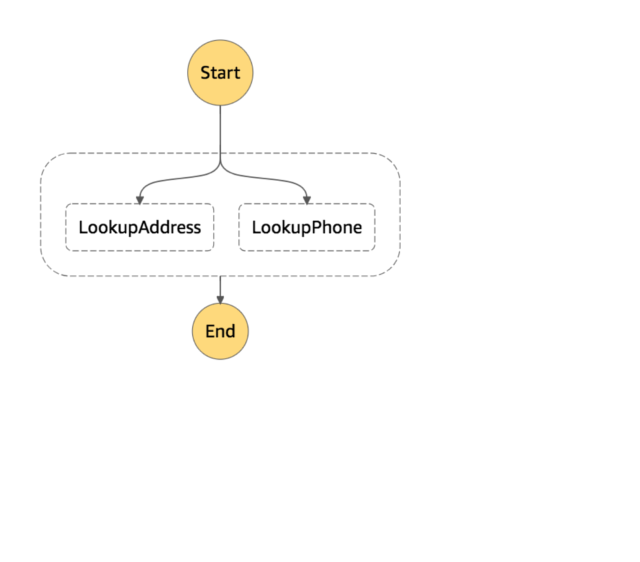Parallel workflow state
Managing state and transforming data
Learn about Passing data between states with variables and Transforming data with JSONata.
The Parallel state ("Type": "Parallel") can be used to add separate branches of execution in your state machine.
In addition to the common state
fields, Parallel states include these additional fields.
-
Branches(Required) -
An array of objects that specify state machines to execute in parallel. Each such state machine object must have fields named
StatesandStartAt, whose meanings are exactly like those in the top level of a state machine. Parameters(Optional, JSONPath only)-
Used to pass information to the state machines defined in the
Branchesarray. Arguments(Optional, JSONata only)-
Used to pass information to the API actions of connected resources. Values can include JSONata expressions. For more information, see Transforming data with JSONata in Step Functions.
Output(Optional, JSONata only)-
Used to specify and transform output from the state. When specified, the value overrides the state output default.
The output field accepts any JSON value (object, array, string, number, boolean, null). Any string value, including those inside objects or arrays, will be evaluated as JSONata if surrounded by {% %} characters.
Output also accepts a JSONata expression directly, for example: "Output": "{% jsonata expression %}"
For more information, see Transforming data with JSONata in Step Functions.
-
Assign(Optional) -
Used to store variables. The
Assignfield accepts a JSON object with key/value pairs that define variable names and their assigned values. Any string value, including those inside objects or arrays, will be evaluated as JSONata when surrounded by{% %}charactersFor more information, see Passing data between states with variables.
-
ResultPath(Optional, JSONPath only) -
Specifies where (in the input) to place the output of the branches. The input is then filtered as specified by the
OutputPathfield (if present) before being used as the state's output. For more information, see Input and Output Processing. -
ResultSelector(Optional, JSONPath only) -
Pass a collection of key value pairs, where the values are static or selected from the result. For more information, see ResultSelector.
-
Retry(Optional) -
An array of objects, called Retriers, that define a retry policy in case the state encounters runtime errors. For more information, see State machine examples using Retry and Catch.
-
Catch(Optional) -
An array of objects, called Catchers, that define a fallback state that is executed if the state encounters runtime errors and its retry policy is exhausted or isn't defined. For more information, see Fallback States.
A Parallel state causes Amazon Step Functions to execute each branch, starting with the
state named in that branch's StartAt field, as concurrently as possible, and
wait until all branches terminate (reach a terminal state) before processing the
Parallel state's Next field.
Parallel State Example
{ "Comment": "Parallel Example.", "StartAt": "LookupCustomerInfo", "States": { "LookupCustomerInfo": { "Type": "Parallel", "End": true, "Branches": [ { "StartAt": "LookupAddress", "States": { "LookupAddress": { "Type": "Task", "Resource": "arn:aws-cn:lambda:region:account-id:function:AddressFinder", "End": true } } }, { "StartAt": "LookupPhone", "States": { "LookupPhone": { "Type": "Task", "Resource": "arn:aws-cn:lambda:region:account-id:function:PhoneFinder", "End": true } } } ] } } }
In this example, the LookupAddress and LookupPhone branches are
executed in parallel. Here is how the visual workflow looks in the Step Functions console.

Each branch must be self-contained. A state in one branch of a Parallel state
must not have a Next field that targets a field outside of that branch, nor can
any other state outside the branch transition into that branch.
Parallel State Input and Output Processing
A Parallel state provides each branch with a copy of its own input data
(subject to modification by the InputPath field). It generates output that is an
array with one element for each branch, containing the output from that branch. There is no
requirement that all elements be of the same type. The output array can be inserted into the
input data (and the whole sent as the Parallel state's output) by using a
ResultPath field in the usual way (see Input and Output
Processing).
{ "Comment": "Parallel Example.", "StartAt": "FunWithMath", "States": { "FunWithMath": { "Type": "Parallel", "End": true, "Branches": [ { "StartAt": "Add", "States": { "Add": { "Type": "Task", "Resource": "arn:aws-cn:states:region:123456789012:activity:Add", "End": true } } }, { "StartAt": "Subtract", "States": { "Subtract": { "Type": "Task", "Resource": "arn:aws-cn:states:region:123456789012:activity:Subtract", "End": true } } } ] } } }
If the FunWithMath state was given the array [3, 2] as input, then both the Add and Subtract states receive that array as input.
The output of the Add and Subtract tasks would be the sum of and difference between the array elements 3 and 2, which is 5 and 1,
while the output of the Parallel state would be an array.
[ 5, 1 ]Tip
If the Parallel or Map state you use in your state machines returns an array of arrays, you can transform them into a flat array with the ResultSelector field. For more information, see Flattening an array of arrays.
Error Handling
If any branch fails, because of an unhandled error or by transitioning to a
Fail state, the entire Parallel state is considered to have
failed and all its branches are stopped. If the error is not handled by the
Parallel state itself, Step Functions stops the execution with an error.
Note
When a parallel state fails, invoked Lambda functions continue to run and activity workers processing a task token are not stopped.
-
To stop long-running activities, use heartbeats to detect if its branch has been stopped by Step Functions, and stop workers that are processing tasks. Calling
SendTaskHeartbeat,SendTaskSuccess, orSendTaskFailurewill throw an error if the state has failed. See Heartbeat Errors. -
Running Lambda functions cannot be stopped. If you have implemented a fallback, use a
Waitstate so that cleanup work happens after the Lambda function has finished.